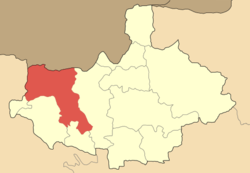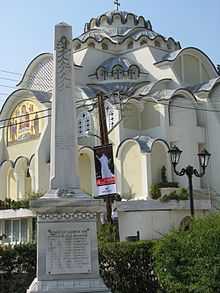Axioupoli
| Axioupoli Αξιούπολη | |
|---|---|
 Axioupoli | |
|
Location within the regional unit  | |
| Coordinates: 40°59′N 22°32′E / 40.983°N 22.533°ECoordinates: 40°59′N 22°32′E / 40.983°N 22.533°E | |
| Country | Greece |
| Administrative region | Central Macedonia |
| Regional unit | Kilkis |
| Municipality | Paionia |
| Population (2001)[1] | |
| • Municipal unit | 6,725 |
| Time zone | EET (UTC+2) |
| • Summer (DST) | EEST (UTC+3) |
| Vehicle registration | ΚΙ |
Axioupoli (Greek: Αξιούπολη), known until 1927 as Boymitsa (Боймица, Μποέμιτσα), is a small town and a former municipality in the former Paionia Province of Kilkis regional unit, Greek Macedonia. Since the 2011 local government reform it is part of the municipality Paionia, of which it is a municipal unit.[2] In 2001 the town had a population of 3,458, and the municipal unit 6,725.
Name
Its ancient name was Atalanti and it was established in prehistoric times.[3] Atalanti was conquered by Bottieans who came into the area in the 12th century BC. In the 5th century BC Atalanti was annexed in the Macedonian kingdom and by that time it followed the Greek history. The Bulgarian and Macedonian name is Boymitsa/Bojmica (Cyrillic: Боймица/Бојмица) by which the town was known until the name was changed in 1927. There have been suggestions that its former name was obtained during the era of Byzantine Empire and its transliteration means strong. Slavic tribes, who entered the area in the 7th century AD, named the area Boymitsa, which means 'little Boymia', because the valley of Axios looks like the Valley of Bohemia (although during the Ottoman era the valley of Axios river used to be called Roumlouki, meaning 'Valley of Greeks'). The town was renamed Axioupoli on 1 January 1927, after the river Axios in its vicinity.
History

Refounded in 1760 by Christian settlers from adjoining areas, they chose it as their new home due to its proximity to the Axios River, near the ruins of ancient town Atalanti. The town form part of the Ottoman Empire until the early 20th century. In the Greek revolution of 1821, inhabitants of Axioupolis and other villages, fought against Ottomans. The family of Papazafiriou Stamatiadi from Idomeni gave the most famous Greek fighters of 1821.[4] The Ottoman troops defeated the rebels in the area, and the revolution continued only in Southern Greece. Construction of Axioupolis' first church, Saint Dimitrios (Greek: Αγίου Δημητρίου), started in 1843 after Christians were given the right to build churches and schools by the Ottomans. Saint Dimitrios was completed in 1859. During the national competitions in the area, a lot of locals resisted in the Internal Macedonian Revolutionary Organization (IMRO) and defend the area.[5] From Idomeni, Nikolaos Stoidis', Stoikos Stoidis' and Dellios Kovatsis' teams act.[5] From Gevgelija, Demosthenes Kyrou organizes the Greek defence in all over the area.[5] From Gevgelija also, Christos Dellios' and Simos Malios' teams act.[5] Athanassios Giangkoulas', Ioannis Taskos' and Petros Charissiadis' teams act from Negorci.[5] In the area of municipality of Axioupolis, there are also the teams of Athanassios Kapetanopoulos and Petros Avramidis from Tikveš.[5] The leaders Nikolaos Nikoltsas, Georgios Xanthos and Dellios Petkou Topalis from Mrzenci had an important participation to the Greek defence in the area.[5] Dellios Petkou Topalis killed in 1898 by Bulgarians.[5]
The first school in town was built in 1894. People of Axioupolis Municipality participated in the Macedonian Struggle, and the main leaders of Greek efforts are mentioned below.
Macedonian Fighters (Makedonomachi):[4]
- Axioupolis: Athanassios Gertzikis (priest), Ioannis Goussidis, Vassilios Papageorgiou, Anastassios Karakechagias, Nikolaos Koulerdas, Christos Kotsidis (priest), Sofia Nikou, Dimitrios Penos
- Ryzia: Vassilios Vantsis, Christos Karamarkos,
- Skra: Dimitrios Papageorgiou, Anastassios Stavridis, Athanassios Tsempis
- Chamilo: Panagiotis Varvatis
- Idomeni: Stylianos Kovatsis Sideras, Grigorios Kokkalis, Georgios Papazafiriou Stamatiadis, Grigorios Papazafiriou Stamatiadis, Zafirios Papazafiriou Stamatiadis
On 22 October 1912 the Ottomans were expelled and the town became part of Greece. During the population exchange of the early 20th century the town was settled by refugees from all over the Balkans and Anatolian regions, giving it a unique feel. Its residence played a big part in helping win the Battle of Kilkis-Lahanas and with the battle of Skra-di-Legen.
Because of its location it has had geopolitical significance, being one of the last places from which the Germans left after World War II ended. The main railway between Thessaloniki and Europe went through the town's center, making Axioupoli a center of information during the Balkan Wars, World War I and World War II. In 1913 the first customs office between Greece and Serbia was opened in Axioupoli.
In World War I the French Army was stationed there to control one of the main supply routes. They helped build numerous projects in town, and within the region, to help with their supply transportation. They built an additional railroad from the center of Axioupoli to Skra (Skora) and the railroad bridge which crosses over the Axios river and leads into Paris. These projects helped change the town as one of Greece's industrialized centers.
On 8 April 1944 the Germans took control of the town, which gave them access to the railroads, bridges and control over the supply routes for the Axis. They occupied the town until 31 October 1944. During the occupation, the Greek People's Liberation Army (Greek People's Liberation Army (ELAS) staged many sabotaged missions against the Axis in the region while residents helped hide Greek fighters from the Germans.
Demographics
| Year | Population |
|---|---|
| 1920 | 1,595 |
| 1928 | 1,945 |
| 1940 | 2,237 |
| 1951 | 2,738 |
| 1961 | 3,564 |
| 1971 | 3,155 |
Location
The town is located 547 km (340 mi) north-northwest of Athens the capital of Greece; 62 km (39 mi) northwest from the regional capital Thessaloniki; 33.9 km (21.1 mi) west from the regional unit capital Kilkis, 3.5 km (2.2 mi) west from the small town of Polykastro. It is West of the Axios River.
Sightseeing
To reach Axioupoli it is most possible to cross [Axios river], which is mentioned on Homer's Iliad as Peones, who used to live in the area, fought in the Troy war. You can visit the Natural History Museum , one of the best in Greece, the Library, [Mega Rema (Kotzadere)], the Statue of Liberty in the main square and the [Metalio Lake], the [big Plane tree] which tradition has as being there since the era of Alexander the Great. Last but not least, it is worth visiting the Blue Lake on mountain Paiko. It is situated between village Koupa and village of Skra, which is internationally famous for the battle that took place there during the first World War, on 17 May 1917.
Education
Axioupoli has a complete system of State schools including one Nursery school, two Primary, two Elementary, one Secondary and one High School. There is also a Technical school (EPAL). Apart from these you can find two Private Foreign Language Schools (Hassapi-Sidera and Sphera).
Famous people born in the town

- Apostol Petkov - Internal Macedonian Revolutionary Organization (IMRO) Revolutionary (1869–1911)
External links
References
- ↑ De Facto Population of Greece Population and Housing Census of March 18th, 2001 (PDF 39 MB). National Statistical Service of Greece. 2003.
- ↑ Kallikratis law Greece Ministry of Interior (Greek)
- ↑ "History of Macedonia I" N. G. L. Hammond, 1972
- ↑ 4.0 4.1 In Greek: Obscure Native Macedonian Fighters" Company of Macedonian Studies (CMS), University Studio Press, Thessaloniki, 2008]
- ↑ 5.0 5.1 5.2 5.3 5.4 5.5 5.6 5.7 In Greek: "The Macedonian Struggle" K. Vakalopoulos, C. Nerantzis, 2000
| ||||||||||||||||||||||